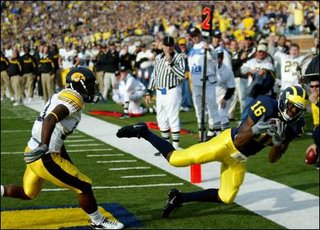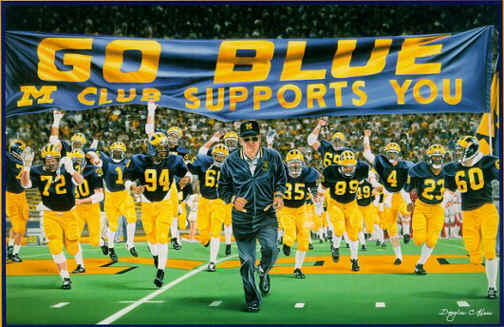Instant Replay
 During the Michigan-Iowa game, there were consecutive incomplete passes in the endzone from Chad Henne to Adrian Arrington. The first play (pictured at right) was not reviewed. The second play was reviewed but the ruling on the field was upheld. Many fans wondered aloud why the first play was not reviewed. Many others seemed to misunderstand when and how plays are reviewed. In an attempt to help alleviate the confusion, here is a link to the Big Ten Conference page on Instant Replay. However, please note the Big Ten orginally posted this in 2005 and it has not updated its site to reflect the rule changes instituted for this season. For your convenience, I am reprinting below the Q & A section of the page:
During the Michigan-Iowa game, there were consecutive incomplete passes in the endzone from Chad Henne to Adrian Arrington. The first play (pictured at right) was not reviewed. The second play was reviewed but the ruling on the field was upheld. Many fans wondered aloud why the first play was not reviewed. Many others seemed to misunderstand when and how plays are reviewed. In an attempt to help alleviate the confusion, here is a link to the Big Ten Conference page on Instant Replay. However, please note the Big Ten orginally posted this in 2005 and it has not updated its site to reflect the rule changes instituted for this season. For your convenience, I am reprinting below the Q & A section of the page:Q. Are the instant replay procedures used by the Big Ten the same as those of the NFL? A. Even though the desired outcome of replay is the same - getting the play right - the manner in which football replay is used in the Big Ten is significantly different than any method the NFL has previously used. The mechanics of Big Ten replay are explained in further detail on the previous page, but simply stated: Neither game officials nor coaches will have the ability to stop game action in order to have the immediately completed play reviewed. All such stoppages and reviews will be conducted by a Technical Advisor in a secure area of the press box.
Q. Which games will have instant replay? A. The NCAA voted to allow all conferences and independent institutions to experiment with instant replay during the 2005 season. In the Big Ten, all intraconference games will utilize the system while home interconference games may also have replay upon the approval of the visiting team.
Q. Will all conferences have the same instant replay system? A. While some conferences will be using an instant replay system that is nearly identical to the Big Ten's version, other conferences may incorporate minor changes, including different equipment, the possibility of coaches' challenges and the use of video from stadium video boards. The complete list of other conferences instituting instant replay in 2005 and possible differences is included later in this section.
Q. What is the intended purpose of the Big Ten's replay system? A. To provide the Technical Advisor with the wherewithal to immediately review plays, and where there is indisputable video evidence, correct specific types of officiating mistakes. What the replay system will not do is guarantee that all officiating mistakes are identified and corrected.
Q. Who can initiate a review of an official's call? A. Only the Technical Advisor serving as the review official for the game. Neither the game officials nor the coaches may ask for a review.
Q. When can a game be stopped to review an official's call? A. The Technical Advisor will look at nearly every reviewable play during the course of the game in search of indisputable video evidence. However, the game will not be stopped unless there is reasonable video evidence that an error may have occurred during a reviewable play. Technical Advisors are also advised to avoid unnecessary interruptions unless it appears that an officiating call may be in error and that the call has a discernable competitive impact on the game.
Q. Who will be making the decision if a call is overturned or not? A. The Technical Advisor will have the sole authority to change a call, or no call, on the field. Unlike the NFL model, officials working Big Ten games will not have the ability or capacity to view the replay(s).
Q. How will the Technical Advisor know that an on-field call by an official will need to be changed? A. Unless in the judgment of the Technical Advisor there is reasonable video evidence that the call on the field was incorrect, then no stoppage of play will occur. If there is reasonable video evidence that an official's call on the field was incorrect, then the Technical Advisor will notify the referee to shut the play down while the call is further reviewed and corrected.
Q. What will be the source of the video for replays? A. All reviewable video will come direct from the television production of the game and no other source. The Big Ten has had 88 percent or more of its 44 intraconference games televised during the past five seasons. If an intraconference game will not be televised, then the Big Ten will arrange for video exposure of the game in order to provide the same, consistent coverage throughout the Conference season.
Q. Who are the Technical Advisors? A. Technical Advisors are former college and/or NFL officials who observe, evaluate and rate game officials' performances and mechanics during games. They report to and are evaluated by David Parry, the coordinator of officials.
Q. How long will instant replay be a rule? A. The NCAA Football Rules Committee voted to allow all conferences and independent institutions to experiment with instant replay during the 2005 season. Following the 2005 season, the Football Rules Committee will review the success of the rule and decide whether it should be added as a permanent rule change.
Q. Will the length of games be affected? A. The use of instant replay did not significantly affect game times as the length of the 57 games utilizing instant replay in 2004 was only three hours and 16 minutes, compared to three hours and 13 minutes in all 2003 contests. Less than one stoppage occurred per game in 2004 and the Big Ten's average length of review was only two minutes and 39 seconds, compared to the National Football League average of three minutes and 20 seconds for its instant replay system.
Q. When can a play be reviewed? A. Only until the ball is put into play on the next play. At that point, the previous play cannot be changed.
Q. Is there a time limit on how long a play can be reviewed? A. There is no time limit...only the standard of indisputable video evidence. If the television replay does not allow the Technical Advisor to apply this standard in a manner that changes the call on the field, then the game plays on.
Q. Briefly describe the mechanics of how a play is reviewed? A. The Technical Advisor will signal the officials on the field that he is reviewing a play, and that game action should be halted. The Technical Advisor will then view replays for as long as necessary to determine whether indisputable video evidence exists for the ruling on the field to be acknowledged as incorrect. Once reviewed the Technical Advisor will notify the referee of the correct call, and time, down and distance, who will announce such to the crowd. Communication between the Technical Advisor in the press box and the referee on the field will be by radio (with a backup phone line).
Q. What if a team is using a hurry-up offense and the Technical Advisor does not have enough time to view a replay to decide whether or not the play is reviewable? A. The decision to stop the game must be made before the ball is snapped. Similar to the NFL, if a team is in a hurry-up offense, it may curtail the ability to completely review some plays.
Q. Is the Technical Advisor limited to the number of plays that can be reviewed? A. No
Q. Will there be sufficient camera angles to review plays from anywhere on the field? A. The replay process will be limited to what is viewable by television cameras. Sometimes a particular angle that might be better will not be immediately available.
Q. What happens if TV comes back from a commercial break after Team A kicks a PAT and shows a better replay that the Team A runner actually did fumble the ball before he crossed the goal line? A. The play still stands as called on the field, since there was no indisputable video evidence to the contrary at the time the touchdown call was made. However, if Team B has called a timeout prior to the PAT, and TV returns from a commercial break with the better replay showing the Team A runner fumbling before crossing the goal line, then the play would be subject to review by the Technical Advisor.
As noted previously, in addition to the above, the NCAA added some additional features to the Instant Replay rules prior to the 2006 season. Once per game, each head coach may also call a timeout and challenge the ruling on the previous play before the next play starts. A coach must have at least one timeout remaining in order to challenge (teams receive three timeouts per half). If the challenge is successful and the on-field ruling is overturned, the team keeps its timeout. If not, the team loses its timeout. In either event, the head coach may not challenge again during the game. Hopefully, the above information clears up some of the confusion surrounding the rules regarding instant replay in the Big Ten Conference. Go Blue!
*Note: Photo of Adrian Arrington (16) by Rashaun Rucker/Detroit Free Press


4 Comments:
First I would like to say that you have an old Replay FAQ posted. This season each head coach has one challange and the game officails can stop the game.
Second I was wondering why the picture of Arrington that you have posted isn't from a second earlier on that play where he pushed off? Iowa's defense could've solved that problem themselves (since the officails weren't calling it) by taking a page out of Michigans book and grabbing recievers, but that doesn't fit Iowa football... not being cheaters and all. They'll leave the cheating biz to teams like Michigan.
I guess he's still bitter about losing to indiana! great blog go blue!
naw... I was bitter about having the chance for a win taken from us by the same officals two years in a row. great blog. go hawks.
Thanks for the comments guys...to Hawks fan- special thanks for the heads up on the fact that Big 10 had not updated their website to reflect the changes in the rule for this season...I've made the changes in the post...as for the officials robbing the Hawkeyes go to the game boxscore at http://mgoblue.com/document_display.cfm?document_id=22474 and look at who was the Umpire: "J. Carr". Any relation? I hope not. Go Blue and thanks again for your comments!
Post a Comment
<< Home